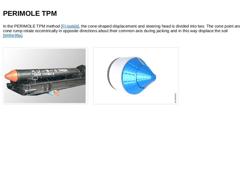
|

In the PERIMOLE TPM method [FI-Isekib], the cone-shaped displacement and steering head is divided into two. The cone point and cone rump rotate eccentrically in opposite directions about their common axis during jacking and in this way displace the soil [Wilhe99a]. (Image: PERIMOLE TPM 200 method for jacking pipes DN/ID 200 [FI-Isekib] - View) (Image: Displacement and steering head of the PERIMOLE method) |
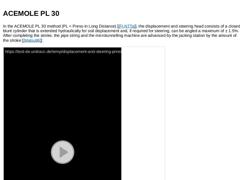
|
In the ACEMOLE PL 30 method (PL = Press-in Long Distance) [ [FI-NTTa]], the displacement and steering head consists of a closed blunt cylinder that is extended hydraulically for soil displacement and, if required for steering, can be angled a maximum of ± 1.5%. After completing the stroke, the pipe string and the microtunnelling machine are advanced by the jacking station by the amount of the stroke [ [Matsu96]]. (Video: Displacement- and steering … |
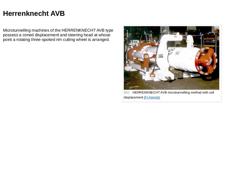
|

Microtunnelling machines of the HERRENKNECHT AVB type possess a coned displacement and steering head at whose point a rotating three-spoked rim cutting wheel is arranged. (Image: HERRENKNECHT AVB microtunnelling method with soil displacement [FI-Herreb]) |
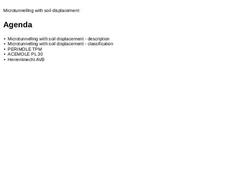
|

|
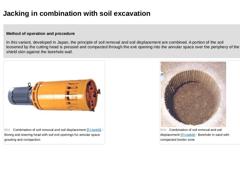
|

Method of operation and procedure
In this variant, developed in Japan, the principle of soil removal and soil displacement are combined. A portion of the soil loosened by the cutting head is pressed and compacted through the exit opening into the annular space over the periphery of the shield skin against the borehole wall. | | | (Image: Combination of soil removal and soil displacement [FI-Isekib] - Boring and steering head with soil exit openings for … |
|
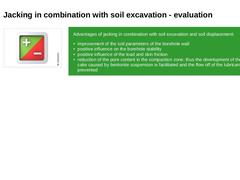
|
|
(Image: Pros and cons) |
Advantages of jacking in combination with soil excavation and soil displacement: -
improvement of the soil parameters of the borehole wall
-
positive influence on the borehole stability
-
positive influence of the load and skin friction
-
reduction of the pore content in the compaction zone; thus the development of the filter cake caused by bentonite suspension is facilitated and the flow off of the lubricant is prevented
|
|
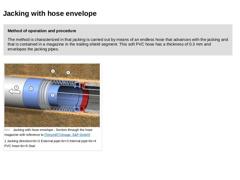
|

|
Method of operation and procedure
The method is characterized in that jacking is carried out by means of an endless hose that advances with the jacking and that is contained in a magazine in the trailing shield segment. This soft PVC hose has a thickness of 0.3 mm and envelopes the jacking pipes. |
|
|
|
(Image: Jacking with hose envelope - Section through the hose magazine with reference to [Tohym87] [Image: S&P GmbH]) |
|
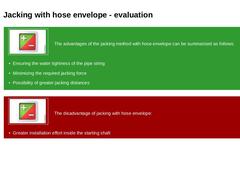
|
|
(Image: Pros and cons)
The advantages of the jacking method with hose envelope can be summarized as follows: -
Ensuring the water tightness of the pipe string
-
Minimizing the required jacking force
-
Possibility of greater jacking distances
|
|
|
|
(Image: Pros and cons)
The disadvantage of jacking with hose envelope: -
Greater installation effort inside the starting shaft
|
|
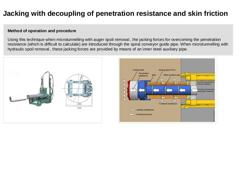
|

|
Method of operation and procedure
Using this technique when microtunnelling with auger spoil removal , the jacking forces for overcoming the penetration resistance (which is difficult to calculate) are introduced through the spiral conveyor guide pipe. When microtunnelling with hydraulic spoil removal , these jacking forces are provided by means of an inner steel auxiliary pipe. |
|
(Image: ENVILINER method of type SH-253 for nominal pipe size DN/ID … |
|
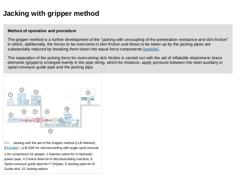
|

|
Method of operation and procedure
The gripper method is a further development of the "jacking with uncoupling of the penetration resistance and skin friction" in which, additionally, the forces to be overcome in skin friction and those to be taken up by the jacking pipes are substantially reduced by breaking them down into equal force components [Isele94].
The separation of the jacking force for overcoming skin friction is carried out with the aid … |
|
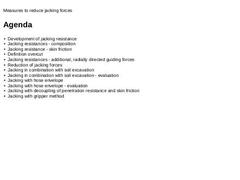
|

|
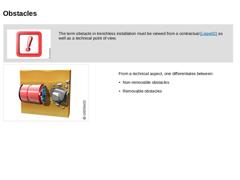
|

|
(Image: Attention!)
The term obstacle in trenchless installation must be viewed from a contractual [Liepe02] as well as a technical point of view. |
|
(Image: Obstacle) |
From a technical aspect, one differentiates between: -
Non-removable obstacles
-
Removable obstacles
|
|
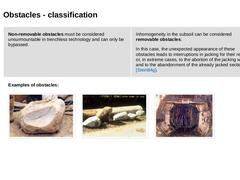
|
|
Non-removable obstacles must be considered unsurmountable in trenchless technology and can only be bypassed. |
Inhomogeneity in the subsoil can be considered removable obstacles. In this case, the unexpected appearance of these obstacles leads to interruptions in jacking for their removal or, in extreme cases, to the abortion of the jacking work and to the abandonment of the already jacked section [Stein84g]. |
|
Examples of obstacles: |
|
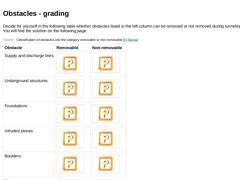
|

Decide for yourself in the following table whether obstacles listed in the left column can be removed or not removed during tunneling. You will find the solution on the following page. (Table: Classification of obstacles into the category removable or non-removable [FI-Steina]) |
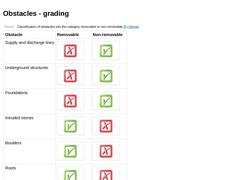
|

(Table: Classification of obstacles into the category removable or non-removable [FI-Steina]) |
|
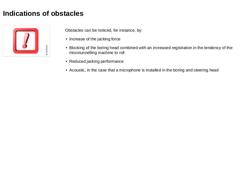
|

Obstacles can be noticed, for instance, by: -
Increase of the jacking force
-
Blocking of the boring head combined with an increased registration in the tendency of the microtunnelling machine to roll
-
Reduced jacking performance
-
Acoustic, in the case that a microphone is installed in the boring and steering head
|
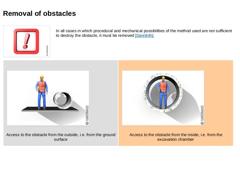
|

|
(Image: Attention!)
In all cases in which procedural and mechanical possibilities of the method used are not sufficient to destroy the obstacle, it must be removed [Stein84h]. |
|
(Image: Unmanned techniques)
Access to the obstacle from the outside, i.e. from the ground surface |
(Image: Manned techniques)
Access to the obstacle from the inside, i.e. from the excavation chamber |
|
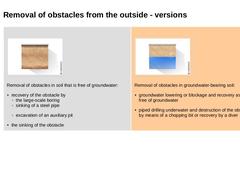
|
|
(Image: Groundwater-free)
Removal of obstacles in soil that is free of groundwater: -
recovery of the obstacle by
-
the sinking of the obstacle
|
(Image: Groundwater-bearing)
Removal of obstacles in groundwater-bearing soil: |
|
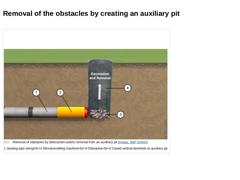
|

(Image: Removal of obstacles by destruction and/or removal from an auxiliary pit) |
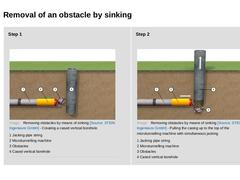
|
|
Step 1 (Image: Removing obstacles by means of sinking - Creating a cased vertical borehole) |
Step 2 (Image: Removing obstacles by means of sinking - Pulling the casing up to the top of the microtunnelling machine with simultaneous jacking) |
|
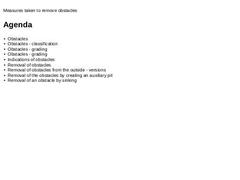
|

|
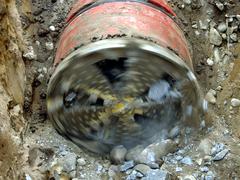
|
Micro tunnelling refers to unmanned, remote-controlled methods for jacking pipes. This module covers the various methods, in particular, micro tunnelling with hydraulic, pneumatic, auger and scraper conveyance and soil displacement. The focus is on removal and processing the spoil, drive variants of the cutting head, cutting head design, application in groundwater, measures to reduce jacking forces and measures to remove obstacles. After completion of this module, you will have a sound knowledge of: - cutting head design;
- processing of the spoil in separation plants;
- measures to reduce jacking resistance; and
- dealing with obstacles.
|
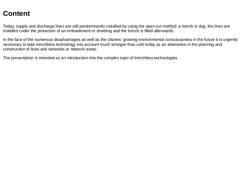
|

Today, supply and discharge lines are still predominantly installed by using the open-cut method: a trench is dug, the lines are installed under the protection of an embankment or sheeting and the trench is filled afterwards. In the face of the numerous disadvantages as well as the citizens' growing environmental consciousness in the future it is urgently necessary to take trenchless technology into account much stronger than until today as an alternative … |
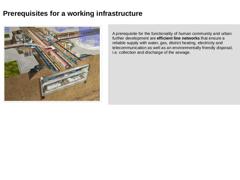
|

|
(Image: Overview of the present underground infrastructures) |
A prerequisite for the functionality of human community and urban further development are efficient line networks that ensure a reliable supply with water, gas, district heating, electricity and telecommunication as well as an environmentally friendly disposal, i.e. collection and discharge of the sewage. |
|

|

|